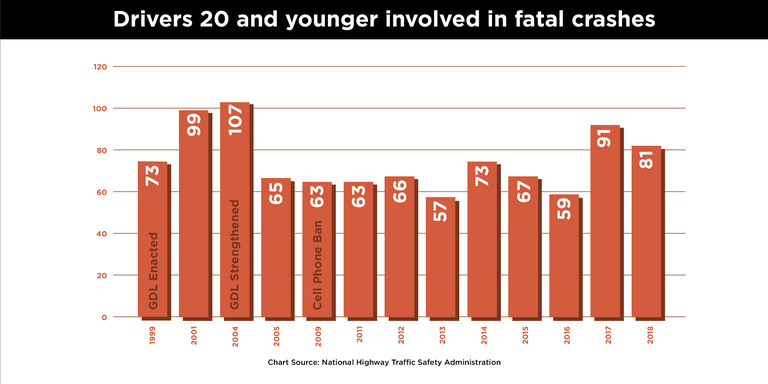CDOT Recognizes National Teen Driver Safety Week October 20 - 26
DENVER – Motor vehicle crashes are the leading cause of death for teens (15-18) in the United States, ahead of all other types of injury, disease, or violence. In 2017, there were 2,247 people killed in crashes involving a teen driver, according to the United States Department of Transportation. To help educate teens and parents across the country about teen driving dangers, National Teen Driver Safety Week was established by the United States Congress in 2007 when a bi-partisan group of lawmakers partnered to introduce a resolution creating the annual week of awareness.
In Colorado, the overall number of young drivers involved in fatal crashes has fallen by almost 50% in the last 20 years. However, in the past two years more fatal crashes are occurring: from 2005 – 2016, Colorado averaged 64 young-drivers involved in fatal crashes per year. In 2017 and 2018 the average was 86 fatalities, an increase of 34 percent.

“When teens receive their driver’s licenses, the first year of driving is the most dangerous,” said CDOT Executive Director Shoshana Lew. “But restrictions placed on those new drivers have contributed to nearly a 50 percent reduction in traffic fatalities involving young drivers over the last 20 years, which is very good news. We must continue to educate teens and their parents about these restrictions if we want to continue to see such positive results.”
Parents can be the biggest influencers on teens’ choices behind the wheel. CDOT recommends all parents discuss with their teenage drivers the key tenants of Colorado’s Graduated Driver License Law, now in its 20th year. The law affects teens under 18 and:
- Forbids other passengers under 21 years old for the first six months of licensure – with only one passenger allowed after six months until the end of the first year
- Bans use of cell phones; and
-
Makes non-use of seat belts a primary traffic offense and requires occupants in back seat to buckle up too
To further educate teens about the GDL law, engaging and informative videos called, ‘GDL Resale’ depict short scenarios with parents offering their teen’s car for sale in the manner of an auctioneer or used car salesperson, as consequences for not abiding the GDL laws. These videos ran on social media last month targeted at teens, and are currently available on CDOT’s website at https://www.codot.gov/safety/colorado-teen-drivers/gdl-resale
For more teen driving tips and resources, visit COTeenDriver.com. For more on National Teen Driver Safety Week, visit https://www.trafficsafetymarketing.gov/get-materials/teen-safety/national-teen-driver-safety-week
WHOLE SYSTEM. WHOLE SAFETY.
To heighten safety awareness, CDOT recently announced its Whole System — Whole Safety initiative. This project takes a systematic statewide approach to safety combining the benefits of CDOT’s programs that address driving behaviors, our built environment and the organization's operations. The goal is to improve the safety of Colorado’s transportation network by reducing the rate and severity of crashes and improving the safety of all transportation modes. The program has one simple mission—to get everyone home safely.
ABOUT CDOT
CDOT has approximately 3,000 employees located at its Denver headquarters and in regional offices throughout Colorado, and manages more than 23,000 lane miles of highway and 3,429 bridges. CDOT also manages grant partnerships with a range of other agencies, including metropolitan planning organizations, local governments and airports. It also administers Bustang, the state-owned and operated interregional express service. Governor Polis has charged CDOT to further build on the state’s intermodal mobility options.
